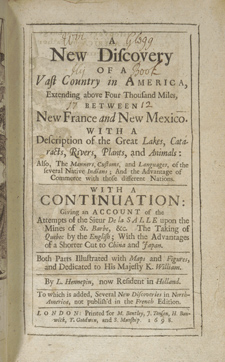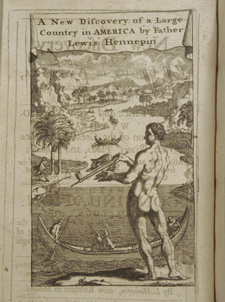
Vanished Worlds, Enduring People
Continuing Encounters
Louis Hennepin. A New Discovery of a Vast Country in America, Extending Above Four Thousand Miles. London: M. Bentley, J. Tonson, H. Bonwick, T. Goodwin, and S. Manship, 1698. [view first image] | [view second image]
Hennepin, a Flemish Franciscan friar, sailed to New France in 1675 and spent the next three years working among the Iroquois as a missionary. He then accompanied René Robert, Sieur de la Salle on his exploration of the Great Lakes and the American Midwest. While searching for the headwaters of the Mississippi River in Minnesota, Hennepin and two others were captured by a group of eastern Sioux and held for nine months.
He returned to France in 1681 and published the first account of his adventures, Description de la Louisiane, in 1683. This book and Nouvelle Découverte d’un tres grand pays, published in 1697, were immensely popular, providing the public with an insider’s view of Indian groups as diverse as the Iroquois and the Sioux. Critics note that Hennepin exaggerated many of his accomplishments. The fanciful frontispiece shown above, in the first English edition of Nouvelle Découverte, incorporates many items associated with native groups across North America.
